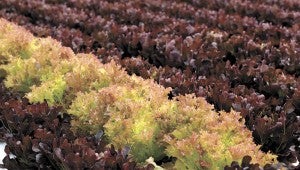Fresh love
Published 10:21 pm Friday, January 23, 2015

Thomas Vandiver shows the range of color in the leaves of a tiny head of oak leaf lettuce, one of the plants SmartBasil Farms specializes in growing.
SmartBasil takes ‘green’ to a new level
The greenhouse effect in Suffolk has more to do with fresh herbs and greens than it does with global warming.
SmartBasil Farms, the 2-year-old venture of three College of William and Mary business school graduates, is situated on 1.5 acres on Turlington Road. It grew out of an assignment for an entrepreneurship program that focused on restaurant sustainability, and the three friends — Eric Coble, John Stein and Thomas VanDiver — decided to take it from paper to plants.
“We thought, ‘This is too big to pass up,’” VanDiver said. “’We’ve got to give it a crack.’”
Growing its namesake basil as well as spring mix, spinach, kale, mesclun greens, heirloom lettuces and more, the outfit operates year-round, thanks to greenhouse and hydroponic growing technology. The company is in the midst of an expansion that will triple its greenhouse space to support a new home-delivery concept.
The company trades on the growing demand for food that is fresh, locally grown and, perhaps most importantly, “real.”
“We’re definitely capitalizing on that energy,” VanDiver said. “Nobody in Virginia is doing this unless it’s this kind of operation.”
VanDiver said basil, especially during the Northern Hemisphere’s winter, is typically grown in Central or South America and flown here.
“Do we want to ship them in on jet fuel or use a little bit of propane (used to heat the greenhouses)?” VanDiver asked. “You could end up eating pesticides that are banned in the U.S. Even if it was grown in California, it’s still been trucked 2,000 miles.”
Plus, he added, “It’s just a better product.”
The greenhouse operation uses well water that is constantly being recycled. Very little — only what evaporates or drips — doesn’t eventually go to nurture a plant.
The plants begin life as seeds in a cocoon made of lava rock teased into a sponge-like state called rock wool. The seedlings sprout in an incubator and then move to trays with holes that are progressively farther apart, allowing more room for the plants to spread their leaves and soak up the light and heat.

Rows of various types of lettuce grow in long hydroponic trays inside a greenhouse on Turlington Road.
Water is pumped into the angled trays and flows downhill, then drains into an angled canal that brings the water back to its starting point. Nutrients are replenished, and the cycle starts over again.
“The plants only take what they want,” VanDiver said.
The growing method, and the fact that the produce arrives in stores, in restaurants or on customers’ doorsteps within a day of being harvested, gives SmartBasil produce the advantage over plants that were likely cut at least a week or two before they show up in the store or on a plate at an eatery.
“That’s why so many of your plants rot before you get a chance to enjoy them,” VanDiver said. “If you eat basil in Hampton Roads, there’s a very good chance that it’s ours, if you’re eating at a restaurant.”
The home delivery service, Neighborhood Harvest, gives folks recipe ideas for its offerings.
“A lot of people have had collards before, but that’s their only experience with cooked greens,” VanDiver said.
His favorite use for basil is pesto. “You just need oil, sea salt, garlic and pine nuts,” he said, adding that the flavor of SmartBasil’s basil is so strong, “You don’t need any sort of additives.”
He also enjoys the lettuce on salads and “microgreens” — mustard, basil and radish seedlings cut at less than two inches high — on eggs.
“There’s so many ways to use our product,” he said. “You’ll never find anything fresher.”







